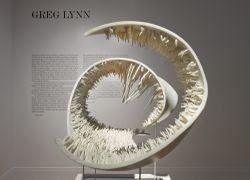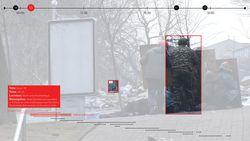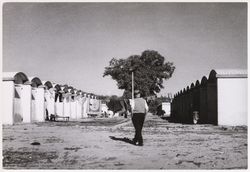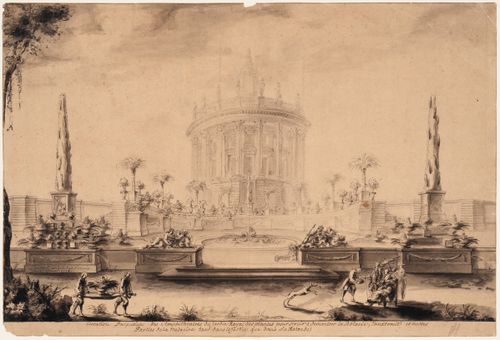Projet
Phun City
AP144.S2.D77
Description:
File documents the executed project for Phun City, a "temporary city" for an outdoor pop music festival at Ecclesden Commons in Sussex, England. Cedric Price was commissioned to coordinate the design and construction of the site, which was to include a stage, tower, cinema, theatre, administration and medical buildings, movable sleeping structures, public toilets, fencing, crash barriers and access roads. Drawings illustrate the development of the functional relationships among activities, as well as, access to, and circulation within, the concert site. A site plan shows the broader context of Ecclesden Commons; keyed diagrammatic plans locate main activity enclosures, pedestrian and vehicular access routes, proposed parking, emergency routes to and from the site, and wire and chain link barriers and fences. A diagrammatic site plan shows the final layout, including last minute alterations prior to the opening of the concert. A second site plan has been marked up with notes indicating how the spectators appropriated the site during the concert, moving some of the portable buildings and circulating in patterns that were different than those anticipated by Price. The client for Phun City Festival, Mick Farren was involved at the Isle of Wright Festival which was held one month later (Price with Murray 1971, 40). Some material in this file was published in "Cedric Price Supplement No. 2", 'Architectural Design', vol. 41, (January 1971), 40, and 'Cedric Price-Works II' (London: Architectural Press, 1984), 18, 30. Material in this file was produced between 1970 and 1971. File contains design development drawings, map, photographic materials, and textual records.
1970-1971
Phun City
Actions:
AP144.S2.D77
Description:
File documents the executed project for Phun City, a "temporary city" for an outdoor pop music festival at Ecclesden Commons in Sussex, England. Cedric Price was commissioned to coordinate the design and construction of the site, which was to include a stage, tower, cinema, theatre, administration and medical buildings, movable sleeping structures, public toilets, fencing, crash barriers and access roads. Drawings illustrate the development of the functional relationships among activities, as well as, access to, and circulation within, the concert site. A site plan shows the broader context of Ecclesden Commons; keyed diagrammatic plans locate main activity enclosures, pedestrian and vehicular access routes, proposed parking, emergency routes to and from the site, and wire and chain link barriers and fences. A diagrammatic site plan shows the final layout, including last minute alterations prior to the opening of the concert. A second site plan has been marked up with notes indicating how the spectators appropriated the site during the concert, moving some of the portable buildings and circulating in patterns that were different than those anticipated by Price. The client for Phun City Festival, Mick Farren was involved at the Isle of Wright Festival which was held one month later (Price with Murray 1971, 40). Some material in this file was published in "Cedric Price Supplement No. 2", 'Architectural Design', vol. 41, (January 1971), 40, and 'Cedric Price-Works II' (London: Architectural Press, 1984), 18, 30. Material in this file was produced between 1970 and 1971. File contains design development drawings, map, photographic materials, and textual records.
File 77
1970-1971
Enrico Chapel, architecte et urbaniste, effectue des recherches sur les ramifications des datascapes contemporains afin de les contextualiser dans le cadre d’une histoire de la représentation urbaine. Cliquez ici pour consulter la liste complète des séminaires de l’été.
1 juillet 2010
Séminaire de chercheur en résidence : Enrico Chapel
Actions:
Description:
Enrico Chapel, architecte et urbaniste, effectue des recherches sur les ramifications des datascapes contemporains afin de les contextualiser dans le cadre d’une histoire de la représentation urbaine. Cliquez ici pour consulter la liste complète des séminaires de l’été.
Projet
AP018.S1.1972.PR08
Description:
This project series documents the second stage of the expansion of the Art Gallery of Ontario (AGO) in Toronto from 1972-1977. The office identified the project number as 7208. This project consisted of the expansion of the AGO that began in 1972. It was Stage II of the expansion program, which began in 1969 with Stage I. Most prominent in this project was the extension of the gallery’s west side to reach Beverley Street. This wing housed the new Education and Extension (E&E) branch galleries and educational facilities, and a two-storey reference library. The library included a 10,000 square foot reading room and an audiovisual library. This stage also proposed an extension to the south of the main gallery, directly east of the Grange mansion, that would connect the AGO to the neighbouring Ontario College of Art. It should be noted that while AGO project contracts were originally given to John B. Parkin Associates, John C. Parkin continued the project under his new firm, Parkin Architects Planners, after parting ways with partner John B. Parkin in 1971. The project is recorded through drawings, photographs, and textual records dating from 1971-1983. The majority of the drawings are reprographic copies of detail drawings arranged with the textual records, although original drawings of details are also present within the textual records. Large drawings housed separately show both the design development and construction of the project. There are also presentation boards showing floor plan schemes. The textual records include contractor and client correspondence, meeting reports, specifications, project notebooks, tender documents, contract data, consultancy records, site reports, certificates of payment and other financial documentation, change orders, supplementary instructions, deficiency lists, detail planning records, and studies. Box AP018.S1.1972.PR08.001 contains an index to the textual records, which was created by the office.
1971-1983
Art Gallery of Ontario, Stage II Expansion, Toronto (1978)
Actions:
AP018.S1.1972.PR08
Description:
This project series documents the second stage of the expansion of the Art Gallery of Ontario (AGO) in Toronto from 1972-1977. The office identified the project number as 7208. This project consisted of the expansion of the AGO that began in 1972. It was Stage II of the expansion program, which began in 1969 with Stage I. Most prominent in this project was the extension of the gallery’s west side to reach Beverley Street. This wing housed the new Education and Extension (E&E) branch galleries and educational facilities, and a two-storey reference library. The library included a 10,000 square foot reading room and an audiovisual library. This stage also proposed an extension to the south of the main gallery, directly east of the Grange mansion, that would connect the AGO to the neighbouring Ontario College of Art. It should be noted that while AGO project contracts were originally given to John B. Parkin Associates, John C. Parkin continued the project under his new firm, Parkin Architects Planners, after parting ways with partner John B. Parkin in 1971. The project is recorded through drawings, photographs, and textual records dating from 1971-1983. The majority of the drawings are reprographic copies of detail drawings arranged with the textual records, although original drawings of details are also present within the textual records. Large drawings housed separately show both the design development and construction of the project. There are also presentation boards showing floor plan schemes. The textual records include contractor and client correspondence, meeting reports, specifications, project notebooks, tender documents, contract data, consultancy records, site reports, certificates of payment and other financial documentation, change orders, supplementary instructions, deficiency lists, detail planning records, and studies. Box AP018.S1.1972.PR08.001 contains an index to the textual records, which was created by the office.
Project
1971-1983
Le rôle élargi: SITU
Bradley Samuels présente le travail récent de SITU Research et le rôle joué par la recherche au sein de la pratique de SITU dans son ensemble. Une série d’études de cas sera présentée, explorant le rôle élargi de la pratique architecturale et spatiale à travers un éventail de domaines, des droits humains à la politique publique, de la science de la terre au design(...)
Théâtre Paul-Desmarais
14 janvier 2016
Le rôle élargi: SITU
Actions:
Description:
Bradley Samuels présente le travail récent de SITU Research et le rôle joué par la recherche au sein de la pratique de SITU dans son ensemble. Une série d’études de cas sera présentée, explorant le rôle élargi de la pratique architecturale et spatiale à travers un éventail de domaines, des droits humains à la politique publique, de la science de la terre au design(...)
Théâtre Paul-Desmarais
Farhan Karim, chercheur en résidence 2016, présente ses recherches : Dans l’évolution récente de l’histoire de l’architecture, l’engagement d’architectes occidentaux auprès des nations postcoloniales émergentes a fait l’objet d’une relecture dans une perspective géopolitique plus vaste de décolonisation et de guerre froide planétaire. Une telle analyse n’est certes pas(...)
Maison Shaughnessy
7 juillet 2016, 18h
Séminaire de chercheur en résidence : Farhan Karim
Actions:
Description:
Farhan Karim, chercheur en résidence 2016, présente ses recherches : Dans l’évolution récente de l’histoire de l’architecture, l’engagement d’architectes occidentaux auprès des nations postcoloniales émergentes a fait l’objet d’une relecture dans une perspective géopolitique plus vaste de décolonisation et de guerre froide planétaire. Une telle analyse n’est certes pas(...)
Maison Shaughnessy
DR1962:0006
Description:
- DR1962:0006 shows a perspective view of a portion of a formal garden terrace laid out symmetrically before a three-storey circular structure. The terrace, which is approached on axis by two steps flanked by sculpted river allegories, is centred on a circular basin and backed by a wall surmounted by potted plants, mostly palm trees and pineapple plants; the middle section of the rear wall curves back concentric to the terrace basin. Beyond the terrace wall and on line with the steps and basin rises the circular structure. With its Corinthian peristyle, this structure has the form of an antique circular temple, such as the so-called "Temple of Vesta" at Tivoli (first century B.C.). Unlike such classical models, however, the columns of the peristyle are set on tall rusticated pedestals that flare outward as they descend to the ground, the entablature carries a balustrade topped by a series of sculpted figures, and the whole is crowned by a tall, slender lantern (although no dome is visible). Within the peristyle, the inner wall is opened regularly by two storeys of windows, each with its own frame and pediment. The overall effect of this structure is not dissimilar to that of James Gibb's Radcliffe Camera, Oxford (1739-49). - In the foreground of DR1962:0006 appear two groups of figures: that on the left consisting of two gardeners carrying a potted pineapple plant, and that on the right consisting of a seated woman attended by a man, a woman (the latter shading her mistress with a parasol), and a figure, apparently a physician, who offers the seated woman a bowl of fruit.
architecture, architecture de paysage
ca. 1744
Project for a medical amphitheatre in the Jardin royal des plantes, Paris
Actions:
DR1962:0006
Description:
- DR1962:0006 shows a perspective view of a portion of a formal garden terrace laid out symmetrically before a three-storey circular structure. The terrace, which is approached on axis by two steps flanked by sculpted river allegories, is centred on a circular basin and backed by a wall surmounted by potted plants, mostly palm trees and pineapple plants; the middle section of the rear wall curves back concentric to the terrace basin. Beyond the terrace wall and on line with the steps and basin rises the circular structure. With its Corinthian peristyle, this structure has the form of an antique circular temple, such as the so-called "Temple of Vesta" at Tivoli (first century B.C.). Unlike such classical models, however, the columns of the peristyle are set on tall rusticated pedestals that flare outward as they descend to the ground, the entablature carries a balustrade topped by a series of sculpted figures, and the whole is crowned by a tall, slender lantern (although no dome is visible). Within the peristyle, the inner wall is opened regularly by two storeys of windows, each with its own frame and pediment. The overall effect of this structure is not dissimilar to that of James Gibb's Radcliffe Camera, Oxford (1739-49). - In the foreground of DR1962:0006 appear two groups of figures: that on the left consisting of two gardeners carrying a potted pineapple plant, and that on the right consisting of a seated woman attended by a man, a woman (the latter shading her mistress with a parasol), and a figure, apparently a physician, who offers the seated woman a bowl of fruit.
architecture, architecture de paysage
archives
Niveau de description archivistique:
Fonds
AP176
Résumé:
Karl Chu X PHYLUM project records, 1998-2014 (predominant 1998-2002), documents the development and design process of Chu’s project X PHYLUM. The archive consists exclusively of original born-digital material.
1998-2014
Documents d’archives de Karl Chu pour le projet X Phylum
Actions:
AP176
Résumé:
Karl Chu X PHYLUM project records, 1998-2014 (predominant 1998-2002), documents the development and design process of Chu’s project X PHYLUM. The archive consists exclusively of original born-digital material.
archives
Niveau de description archivistique:
Fonds
1998-2014
documents textuels, né numérique, archives
Niveau de description archivistique:
Fonds
Fonds Anyone Corporation
AP116
Résumé:
The Anyone Corporation fonds is composed primarily of textual and photographic records which document the activities of the Anyone Corporation over the course of its planned ten year life span from 1990 to 2001. The non-profit, New York City based organization, was founded by Peter Eisenman, Cynthia Davidson, Arata Isozaki, and Ignasi de Solà-Morales Rubio in order to stimulate a fruitful dialogue between architecture and general culture at the dawn of the new millennium. To this end, ANY (acronym for Architecture New York) organised ten international conferences and numerous public seminars, as well as publishing conference journals, a series of architecture related books, and ANY, a theory driven bi-monthly magazine.
1990-2001
Fonds Anyone Corporation
Actions:
AP116
Résumé:
The Anyone Corporation fonds is composed primarily of textual and photographic records which document the activities of the Anyone Corporation over the course of its planned ten year life span from 1990 to 2001. The non-profit, New York City based organization, was founded by Peter Eisenman, Cynthia Davidson, Arata Isozaki, and Ignasi de Solà-Morales Rubio in order to stimulate a fruitful dialogue between architecture and general culture at the dawn of the new millennium. To this end, ANY (acronym for Architecture New York) organised ten international conferences and numerous public seminars, as well as publishing conference journals, a series of architecture related books, and ANY, a theory driven bi-monthly magazine.
documents textuels, né numérique, archives
Niveau de description archivistique:
Fonds
1990-2001
Projet
Detroit Think Grid
AP144.S2.D73
Description:
File documents Detroit Think Grid, an unrealized project for a series of experiments which were to be developed by Price in collaboration with various groups in the Greater Detroit and Oakland area and implemented over a five-year period. Collaborators were to include the municipality, industry, commerce, and the existing education network, particularly Oakland County Community College in Detroit, Michigan. The principle aim of the Detroit Think Grid was to make the education "system" flexible and responsive to the needs of the community and readily accessible to everyone. Detroit Think Grid components include mobile units such as swimming pools, public learning booths and packaged workshops. Material in this group consists of existing conditions documentation concerning Oakland County and Oakland Community College campuses, such as aerial photographs of streets, zoning maps and maps of various townships, maps of traffic flow in Oakland County, and site plans of Oakland Community College campuses. Design development drawings include zoning plans showing present and projected uses of various zones, major transportation modes, patterns, and access points, and predictions for general population, school population, and retail growth within Oakland County. Material from this file was published in "Cedric Price Supplement No. 3", 'Architectural Design', vol. 41, (June 1971), 353-363 and 'Cedric Price-Works II' (London: Architectural Press, 1984), 54, 66. Material in this file was produced between 1957 and 1975, but predominantly between 1969 and 1971. Cedric Price presented a conference at the Cranbrook Institute of Science, in Michigan in 1968 and produced 2 reports for them titled 'Oakland Community College: An Investigation into Educational Servicing' (1968) and 'Oakland Community College: An Investigation into New Forms of Learning' (1968). File contains cartographic materials, design development drawings, photographic materials, reference drawings, and textual records.
1957-1975, predominant 1969-1971
Detroit Think Grid
Actions:
AP144.S2.D73
Description:
File documents Detroit Think Grid, an unrealized project for a series of experiments which were to be developed by Price in collaboration with various groups in the Greater Detroit and Oakland area and implemented over a five-year period. Collaborators were to include the municipality, industry, commerce, and the existing education network, particularly Oakland County Community College in Detroit, Michigan. The principle aim of the Detroit Think Grid was to make the education "system" flexible and responsive to the needs of the community and readily accessible to everyone. Detroit Think Grid components include mobile units such as swimming pools, public learning booths and packaged workshops. Material in this group consists of existing conditions documentation concerning Oakland County and Oakland Community College campuses, such as aerial photographs of streets, zoning maps and maps of various townships, maps of traffic flow in Oakland County, and site plans of Oakland Community College campuses. Design development drawings include zoning plans showing present and projected uses of various zones, major transportation modes, patterns, and access points, and predictions for general population, school population, and retail growth within Oakland County. Material from this file was published in "Cedric Price Supplement No. 3", 'Architectural Design', vol. 41, (June 1971), 353-363 and 'Cedric Price-Works II' (London: Architectural Press, 1984), 54, 66. Material in this file was produced between 1957 and 1975, but predominantly between 1969 and 1971. Cedric Price presented a conference at the Cranbrook Institute of Science, in Michigan in 1968 and produced 2 reports for them titled 'Oakland Community College: An Investigation into Educational Servicing' (1968) and 'Oakland Community College: An Investigation into New Forms of Learning' (1968). File contains cartographic materials, design development drawings, photographic materials, reference drawings, and textual records.
File 73
1957-1975, predominant 1969-1971
Série(s)
AP185.S2
Description:
This project, 1994-2001, contains material related to the Ost/Kuttner Apartment, a built residential project in New York City. Described by its clients as “Cleopatra’s submarine,” the O/K Apartment converts two adjacent units in a pre-World War II building in New York into a single but divisible space. The Apartment is organized into areas defined less by their programmatic identity—bathroom, bedroom, living room—than by a series of undulating landscapes made up of custom, function-bridging forms, which KOL/MAC developed by digitally compositing cross-sections of everyday domestic objects. To produce the pieces, the architects worked intensively with contractors in a process directly informed by computer-aided fabrication in a variety of fields including ship-building, bobsled design, and stage design. The digital project records are largely in word processing formats, namely Microsoft Word for Mac and ClarisWorks, as well as images in TIF, JPEG, and Mac Pict image formats. There are also a large number of Microstation CAD drawings. There are two major groupings within the digital material: First, there is a body of video and still images. These consist of screen captures of renderings and other digital models. There are also images and HTML for a related website, a photograph viewer showing pictures of a built, physical model of the apartment. Of note, there are two videos which document the early construction of the Apartment, as well as the construction of the shower/bed. The second grouping consists of construction and design documentation. This consists of correspondence, invoices, and other word processing documents which show KOL/MAC’s work with the client, contractor, engineer, and other stakeholders. They also contain a large number of design files and images which document the evolving design of the Apartment. KOL/MAC versioned their working files at certain intervals, and each version represents a snapshot of the working files at a particular time. There is a substantial amount of duplication across these files. There is also a physical component to the records, including three material samples from the apartment, as well as 28 floorplans for the bid set, 6 floorplans, and 2 blueprints. There is also .3 linear meters of textual records which document KOL/MAC’s work with the client, contractor, and sub-contractor during construction.
1994-2001
O/K Apartment (New York, N.Y.)
Actions:
AP185.S2
Description:
This project, 1994-2001, contains material related to the Ost/Kuttner Apartment, a built residential project in New York City. Described by its clients as “Cleopatra’s submarine,” the O/K Apartment converts two adjacent units in a pre-World War II building in New York into a single but divisible space. The Apartment is organized into areas defined less by their programmatic identity—bathroom, bedroom, living room—than by a series of undulating landscapes made up of custom, function-bridging forms, which KOL/MAC developed by digitally compositing cross-sections of everyday domestic objects. To produce the pieces, the architects worked intensively with contractors in a process directly informed by computer-aided fabrication in a variety of fields including ship-building, bobsled design, and stage design. The digital project records are largely in word processing formats, namely Microsoft Word for Mac and ClarisWorks, as well as images in TIF, JPEG, and Mac Pict image formats. There are also a large number of Microstation CAD drawings. There are two major groupings within the digital material: First, there is a body of video and still images. These consist of screen captures of renderings and other digital models. There are also images and HTML for a related website, a photograph viewer showing pictures of a built, physical model of the apartment. Of note, there are two videos which document the early construction of the Apartment, as well as the construction of the shower/bed. The second grouping consists of construction and design documentation. This consists of correspondence, invoices, and other word processing documents which show KOL/MAC’s work with the client, contractor, engineer, and other stakeholders. They also contain a large number of design files and images which document the evolving design of the Apartment. KOL/MAC versioned their working files at certain intervals, and each version represents a snapshot of the working files at a particular time. There is a substantial amount of duplication across these files. There is also a physical component to the records, including three material samples from the apartment, as well as 28 floorplans for the bid set, 6 floorplans, and 2 blueprints. There is also .3 linear meters of textual records which document KOL/MAC’s work with the client, contractor, and sub-contractor during construction.
Series
1994-2001



